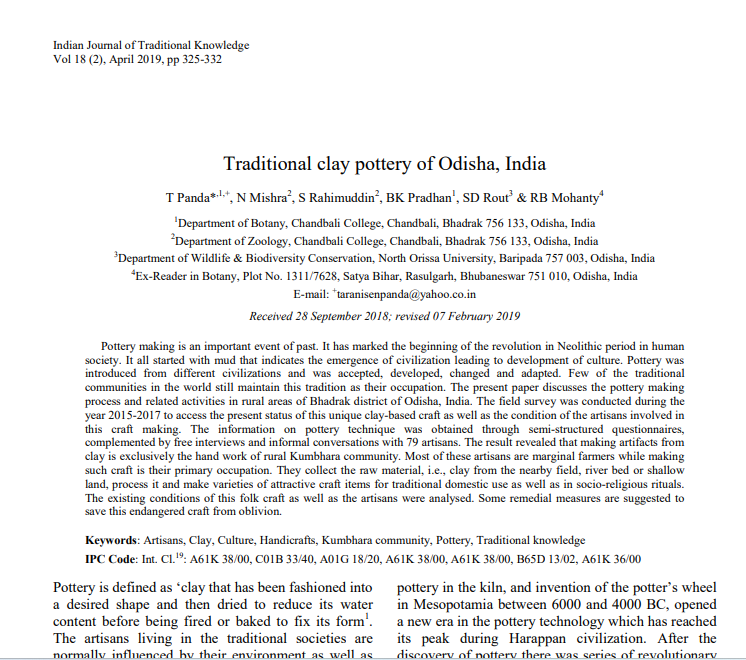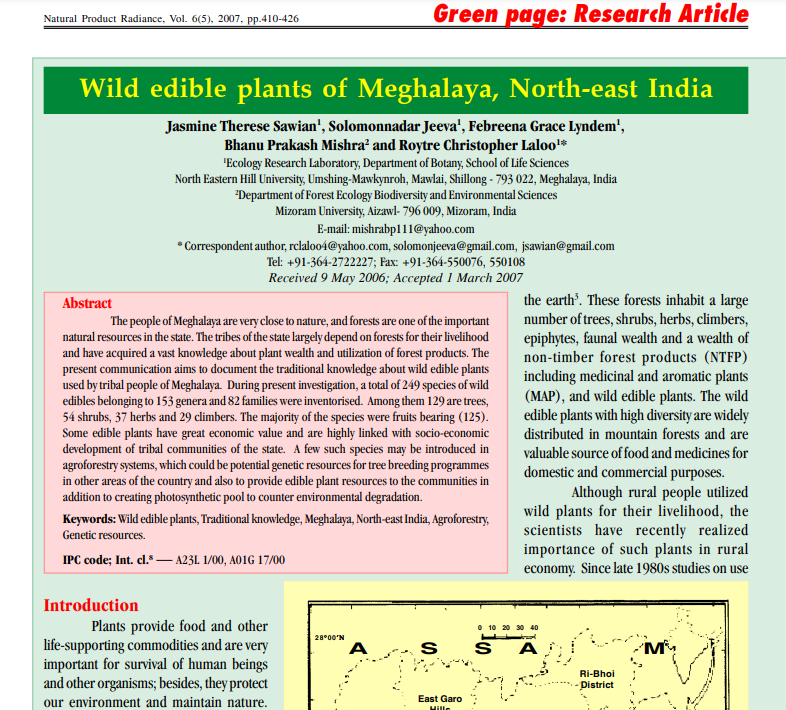Knowledge Hub
Wild Edible Plants of Majuli Island and Darrang Districts of Assam
2007
Author(s): Barua U , Hore DK, Sarma R
The paper deals with 38 wild edible plants of Majuli island and Darrang districts.

Plant Diversity in Betel Leaf Agroforestry of South Meghalaya, Northeast India
2018
Author(s): Tynsong H, Tiwari BK, Dkhar M
The betel leaf agroforestry with diverse and structurally complex shade canopies conserve a significant portion of the original forest biodiversity. The impact of land-use change on biodiversity was studied using standard vegetation analysis and biodiversity estimation methods.
Medicinal Plants Used Against Gastrointestinal Tract Disorders by the Traditional Healers of Sikkim Himalayas
2007
Author(s): Chanda R, Mohanty JP , Bhuyan NR, Kar PK, Nath LK
Ethnomedicinal survey of various tribes in the four districts of Sikkim reveals the use of medicinal plants. The paper records ethnomedicinal values of 36 plants species belonging to 27 families having the activities in gastrointestinal tract disorders.
Namdung (Perilla ocymoides): A Bioculturally Rich Plant in Food and Livelihood Security of Adi Women in Arunachal Pradesh, Eastern Himalaya
2012
Author(s): Singh RK, Singh A, Bhardwaj R
This study was conducted with Adi women on Namdung plant (Perilla ocymoides). Objectives were to explore food, cultural and ethnomedicinal values of Namdung. Data were collected from 180 rural Adi women from 6 villages of East Siang district and secondary sources also.
Medicinal Plants Used by Different Tribes of Cachar District, Assam
2008
Author(s): Das AK, Dutta BK, Sharma GD
This paper provide information regarding the uses of medicinal plants by the different tribes/communities settled in the Cachar district of Assam. Out of 107 plant species, some are being used against jaundice, diarrhoea, dysentery, cough, malarial fever, skin diseases, sexual diseases, etc.
Traditional Knowledge: Considerations for Protecting Water in Ontario
2012
Author(s): McGregor D
The article highlights progress made to date and provides Indigenous viewpoints on what further steps need to be taken. Key among these steps is the need to restore and maintain Indigenous access to traditional territories and ways of life, and the requirement for mutually respectful collaboration between TK and Western science.
Traditional Knowledge of Kani Tribals in Kouthalai of Tirunelveli Hills, Tamil Nadu, India
2005
Author(s): Ayyanar M, Ignacimuthu S
An ethnobotanical survey was carried out among the ethnic groups (Kani/Kanikaran) in Southern Western Ghats of India. Traditional uses of 54 plant species belonging to 26 families are described under this study.

Traditional Clay Pottery of Odisha, India
2019
Author(s): Panda T, Mishra N , Rahimuddin S , Pradhan BK , Rout SD & Mohanty RB
The present paper discusses the pottery making process and related activities in rural areas of Bhadrak district of Odisha, India. The field survey was conducted during the year 2015-2017 to access the present status of this unique clay-based craft as well as the condition of the artisans involved in this craft making.
Non-Timber Forest Products (NTFPs) Used by Garo Tribe of Rongram Block in West Garo Hills, Meghalaya
2019
Author(s): Sangma AJT, Lalnundanga
The paper construct socio-economic profile and document the availability of NTFPs used by Garo Tribe of Rongram Block in West Garo Hills, Meghalaya. The study reveals that the Garos are blessed with abundant natural resources of NTFPs with which they can develop their way of living mainly by fuelwood and honey business in a sustainable way.

Wild Edible Plants of Meghalaya, North-East India
2007
Author(s): Sawian JS, Jeeva S, Lyndem FG, Mishra BP, Laloo RC
The present communication aims to document the traditional knowledge about wild edible plants used by tribal people of Meghalaya. During present investigation, a total of 249 species of wild edibles belonging to 153 genera and 82 families were inventorised. Among them 129 are trees, 54 shrubs, 37 herbs and 29 climbers.



